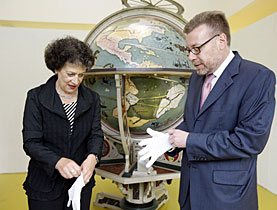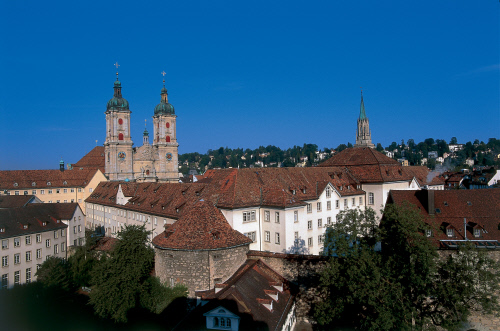Heads turn at St Gallen globe unveiling

A spat between cantons over who owned a huge globe stolen by Zurich troops from St Gallen nearly 300 years ago has come one step closer to its conclusion.
Officials from canton Zurich on Tuesday unveiled an exact copy of the original globe – the fruit of 7,000 hours of work – which is a gift to canton St Gallen. The original, however, will stay in Zurich.
The replica will be handed over to St Gallen on August 21 in the presence of Interior Minister Pascal Couchepin. This act should mark the definitive end to the dispute.
“It’s a successful piece of work and a scientific project. It’s a good and beautiful conclusion to this rather difficult disagreement over a cultural good with canton St Gallen,” Markus Notter, head of canton Zurich’s justice and interior department, told swissinfo.ch at a media conference to present the new globe.
The German-made original, which measures 1.2 metres in diameter, is only one of a few large 16th century globes in existence. The fact that it shows both the heavens and the earth on one sphere is thought to make it unique.
It was stolen by Zurich troops as war booty in 1712. Since the end of the 19th century it has been on display at the city’s Swiss National Museum.
In 1996, prompted by a letter to a newspaper, discussions flared up over ownership. It took ten years of – sometimes acrimonious – negotiations before a good Swiss compromise was found.
Couchepin brokered the deal which saw canton Zurich keep the original, if it agreed to fund and make an exact replica for canton St Gallen.
St Gallen pleased
Kathrin Hilber, head of canton St Gallen’s interior department, told swissinfo.ch that she was very happy with the copy, which had taken a lot of effort to make. She said it showed that peace had been made.
“It will now been shown in the St Gallen World Heritage site and a notice will be put up that the original lies 80 kilometres west. It will be very important, it’s a symbol,” she said.
Making a replica of the old globe has been a painstaking process, which has, over 18 months, involved 7,000 hours of work and more than 50 people. The total cost was around SFr860,000 ($794,000).
Specialists first had to investigate the fragile sphere without touching it to ascertain how it was made and what needed to be done. For this they were aided by x-rays and spectrometry.
Old methods
A wagon-maker was then drafted in to make the wooden shell and a coppersmith agreed to make the screws using old techniques. Papier-mâché was later added to give the object its round shape.
The decoration was the next challenge. “The painting used historical colours which are much harder to use than today’s colours and then calligraphy was added,” said Beat Gnädinger, canton Zurich’s archivist and the project’s leader.
The result is a globe full of vibrant colours, as the original – now somewhat faded – must have looked when it was finished.
Not much is known about the old globe. It is believed to have been made in 1571 for a rich German family in Augsburg. It eventually found its way to the Abbey Library in St Gallen in around 1600, before it was taken to Zurich.
World view of 1571
“The original globe shows what was known in 1571. It was at that point a very modern and up-to-date view of the world, in all senses of the phrase, combined with other information, such as mythical art and a more or less complete view of the heavens,” Gnädinger told swissinfo.ch.
It contains a relatively exact picture of Europe, as well as the coastal outlines of Africa. South America is mostly shown as the Amazonia, and the Antarctic is painted according to the myth of the times, as a counterbalance at the bottom of the world to stop it falling over.
Australia doesn’t exist, but Asia is quite well depicted because of the trading roots to the continent, the archivist said.
“What is almost totally empty – and this is very marked – is America. There’s the Wild West and the coast, but otherwise it’s empty,” he added.
After the official handover in August, the public will be able to look for themselves. For a year it will be on display in the world heritage St Gallen Abbey Library, from where the original was taken in 1712.
Isobel Leybold-Johnson in Zurich, swissinfo.ch
1571: original made in 1571 for the Fugger banking family in Augsburg Germany.
1595: it goes via Constance to the St Gallen Abbey.
1712: Zurich troops steal the globe as booty during a religious war.
1897: After being housed in several museums, the globe ends up in the Swiss National Museum. The museum is still the official owner.
1996: Spat breaks out over ownership.
2006: Swiss government announces agreement has been made. Zurich keeps the original, but has to pay for and construct an exact copy. This is to be given as a gift to St Gallen.
2009: Officials announce globe replica is ready. This will be handed over on August 21.

In compliance with the JTI standards
More: SWI swissinfo.ch certified by the Journalism Trust Initiative












You can find an overview of ongoing debates with our journalists here . Please join us!
If you want to start a conversation about a topic raised in this article or want to report factual errors, email us at english@swissinfo.ch.